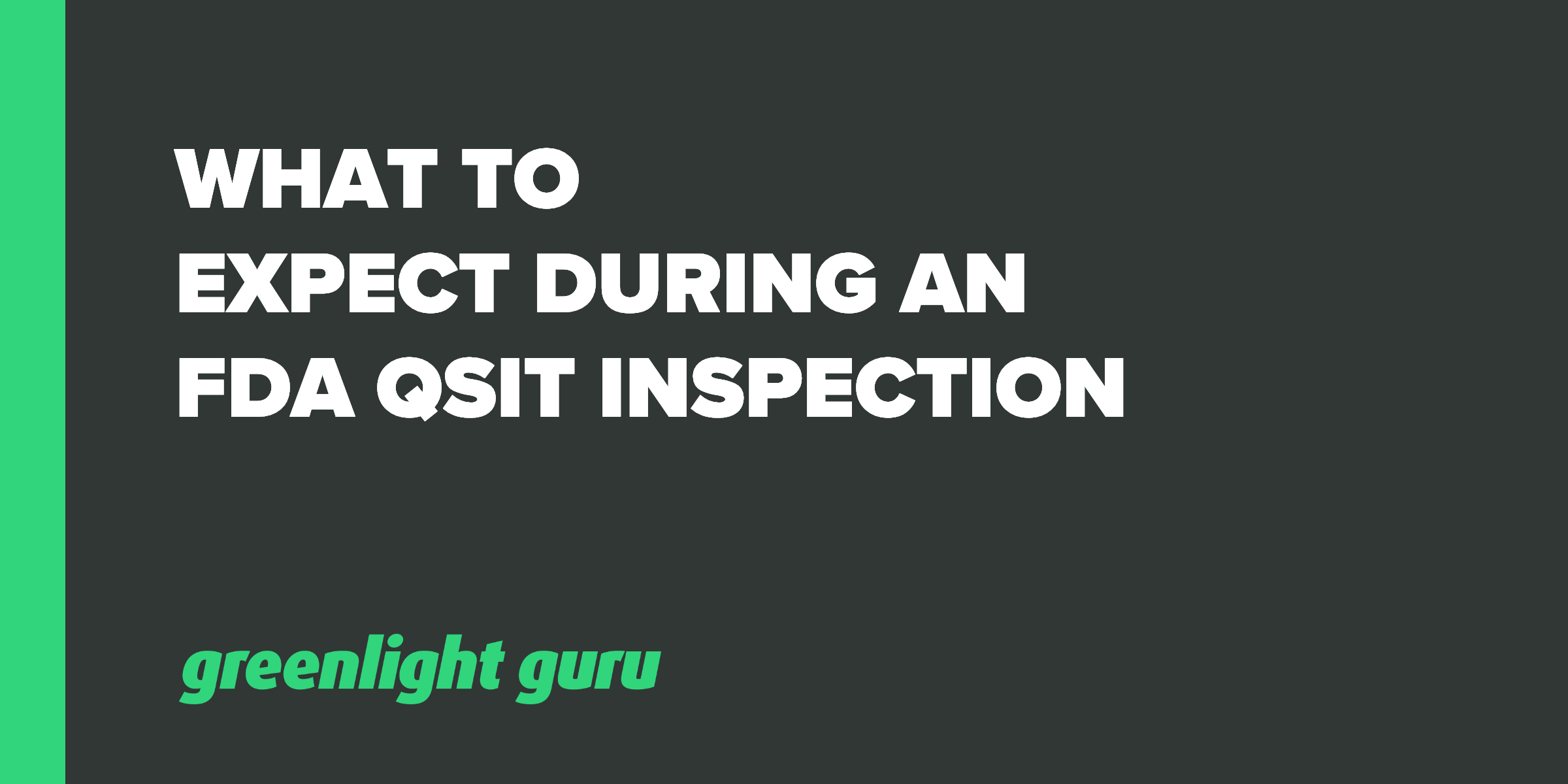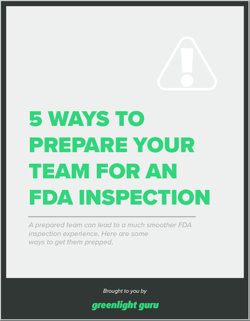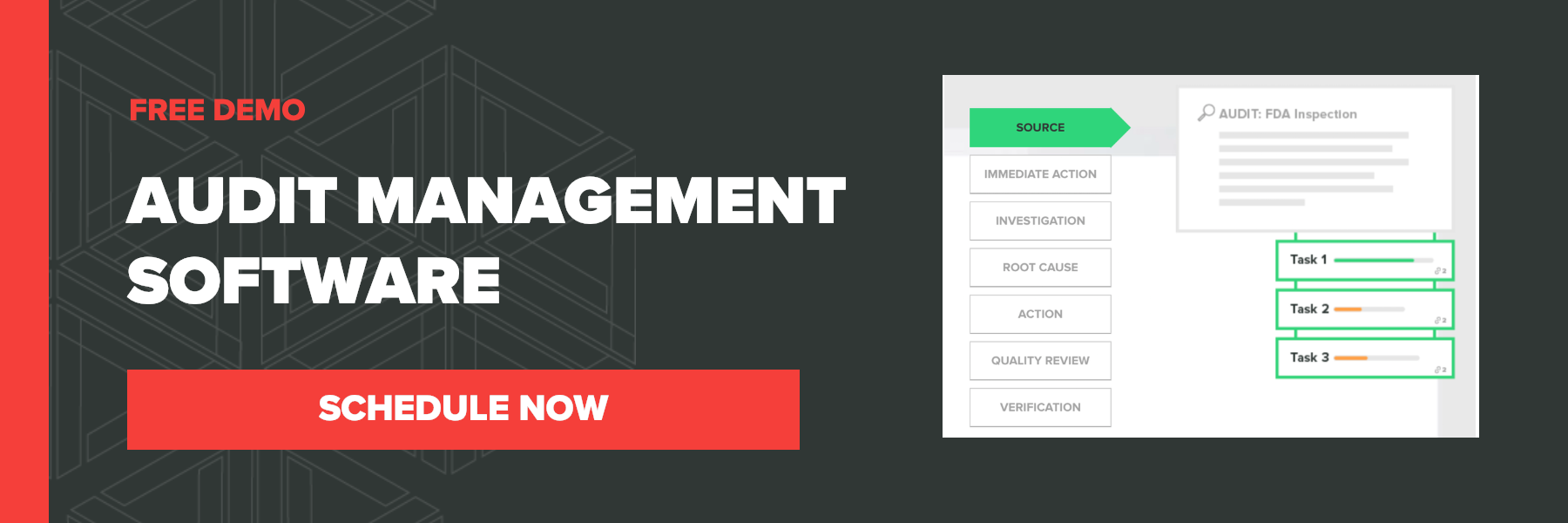
You arrive at work one morning and there are FDA inspectors sitting in your waiting area. If you are lucky, you may have been notified ahead of time that they’re coming, but otherwise, FDA is fully within their own rights to show up unannounced at any time. Because of this, your company must be prepared at all times.
In past blog posts, I've shared several ways in which you can plan ahead for inspections to ensure they go as smoothly as possible. But what if you're past that point in the process? What if you get a knock on your door and it's a surprise visit from an inspector? I'm sure you'd like to know what will happen next, and what you should know in the moments after the shock and panic subside--both from an inspector's point of view, and your own.
Key Terms To Know For a QSIT Inspection
As you're probably well aware, the medical device industry is packed with confusing terms and cryptic regulations. For an FDA inspection, specifically, there are some important key terms and definitions you should be familiar with:
- QSIT: Quality System Inspection Technique.
- The Guide to Inspections is the set of protocols used by FDA to conduct an inspection.
- QSR: Quality System Regulations.
- The primary regulatory requirement being inspected by FDA is 21 CFR Part 820.
- QSR subsystems: A QSIT inspection focuses on 4 major subsystems of the Quality System that establish the basis for what FDA inspectors will review:
- (1) Management Controls, (2) CAPA, (3) Design Controls and (4) Production and Process Controls.
- Other inspection-related regulatory requirements include:
- 21 CFR 801: Labeling
- 21 CFR 803: Medical Device Reporting
- 21 CFR 806: Reports of Corrections and Removals
- 21 CFR 807: Establishment Registration and Device Listing
- 21 CFR 810: Medical Device Recall Authority
- 21 CFR 830: Unique Device Identification
- “As applicable” means that the regulations outlined must be followed as applicable to the specific organization and medical device.
- Some regulations may not be relevant to you, for example, Class I devices do not require design controls. It is up to your company to determine what is applicable to you, perhaps with the assistance of a regulatory consultant.
There are also 4 different types of FDA inspections, which are important to know what each are for and how they’re conducted.
What to expect During a QSIT Inspection
When an inspector first enters your facility, they should be greeted by someone who your company has designated as the coordinator for the inspection. This person should be someone who can escort the inspector, help guide them to the information they’d like to inspect and address any questions or concerns they may have.
Inspectors are required by law to show their credentials upon conduction of an inspection. You may choose to record those credentials by writing down the name and ID number, but it is prohibited to make any physical copies of the credential badge. All FDA inspections must begin by the agent presenting the company with a FDA 482 form, known as a Notice of Inspection. If you have not received one prior to the arrival of the inspector, they should provide you with one prior to the commencement of the inspection.
One of the first things to happen next will usually be some kind of introductory meeting, where the inspector explains the purpose of the inspection (it will be one of the four main types of inspection, as touched on in the previous section). You should also have a designated area that you've prepared for the inspector to use as a “base” from which to work.
The QSIT Method
The Quality System Inspection Technique, also known as the QSIT method, is a “top-down” approach to an inspection, which means that inspectors will generally begin by asking to see your procedures first, then drilling down further into your quality records. Your records are your proof. They should demonstrate that you are following your written procedures, supported by all ongoing activities. You can expect the inspector to ask for any/all of the following:
- To see your procedures.
- To interview key personnel within your organization.
- To learn more about your processes.
- To review the records that back up your processes.
- They may wish to take a sampling with them as it is not possible for them to review absolutely everything in one sitting.
If you are having a full routine inspection, you can expect that a Level 2 Baseline QSIT will be conducted, which is a comprehensive review of all four main subsystems. This is often structured to take around four days, often with one subsystem inspected per day. You can expect that individual inspectors may have their own preferences though - for example, one may want to spend more time on a particular subsystem.
How inspectors prepare for QSIT Inspections
Inspectors will prepare ahead of time to visit your particular facility. If this is your very first inspection, then they’re working from a blank slate or perhaps relying on information you submitted from a pre-approval.
If you have been inspected previously, an inspector will use that information to prepare for the next one. For example, they may look at:
- Previous reports.
- Previous 483 observations or warning letters.
- Previous responses to 483 observations or warning letters.
- Your firm’s website and marketing materials.
- Any consumer complaints or recalls that have occurred since the last inspection.
What if an Inspector finds an Issue During a QSIT Inspection?
If an inspector becomes aware of potential quality issues during the course of the inspection, they may wish to conduct a more detailed inspection of specific areas within your quality system. It’s worth having someone, aside from the person coordinating the inspection, who can be available to take notes.
This note-taker can record things like specific questions asked and documents that are inspected. This will prove to be very beneficial for reference later on in the process or at a future date. In addition, if you believe there's a strong likelihood you'll receive a 483 observation or FDA warning letter, you can get a head start on rectifying whatever the issue is by this record keeping practice.
You should also expect that every inspector is different. I often refer to the fact that FDA inspectors are only human, just like the rest of us. You can expect different levels of experience, different personalities and different interests among inspectors. For example, one may pay much closer attention to a certain area than another - this often comes down to their own experience and personal preference.
The closing meeting of a QSIT Inspection
Once the inspector has finished with each area of the QSIT that they are there to observe, they will usually remain at the facility while they summarize their initial findings. Once they have their final report, they will request a closing meeting with the company's inspection coordinator and any senior-level managers.
During this closing meeting, the inspector may share their findings and indicate what may or may not result in the issuance of FDA Form 483 - an official list of findings that the company needs to address. If there are any observations, the inspector will usually give the company the opportunity to discuss them and make any clarifications to defend their position.
At this point in the process, if you are presented with any findings that require future action on your part, you don’t have to agree to any specific actions or timeframe at that point in time. You can agree to correct those findings as part of your response to the official report. You have 15 calendar days from receipt of Form 483 to send a response to FDA. If you fail to meet this deadline, it's likely that those observations will be upgraded to a warning letter.
Of course, an alternative end result may turn out to have no observations at all, which is the ultimate goal! Once you reach the conclusion phase of the inspection, the report usually indicates one of the following classifications:
- NAI - No Action Indicated
- VAI - Voluntary Action Indicated
- OAI - Official Action Indicated
After the QSIT inspection
Following the quality system inspection of your medical device company, the inspector will write up an official Establishment Inspection Report and communicate all findings with their district. You can usually obtain an official copy of the report within 60 days.
If you did receive any observations, then you must respond within that 15 calendar day timeframe; otherwise, you’re free to take any voluntary actions that were mentioned as you see fit, or carry on as you were. One of my preferences is to always look for the proactive steps you can take toward continuous improvement.
As medical device manufacturers, you can expect to be inspected. If you're lacking the infrastructure of a true quality system, it's going to be very hard to take advantage of the free advice and resources available to help you prepare. Greenlight Guru's QMS software is designed to meet their unique needs of medical device companies, with a dedicated Audit Management feature workflow. Preparing for an inspection has never been easier--you might even look forward to your next one.
Jon Speer is a medical device expert with over 20 years of industry experience. Jon knows the best medical device companies in the world use quality as an accelerator. That's why he created Greenlight Guru to help companies move beyond compliance to True Quality.
Related Posts
FDA QSIT: Preparing Your Medical Device Company for an Inspection
Why Getting FDA 510(k) Clearance Alone is Not Enough (And 6 Things You Can Do About It)
Here Are the 4 Types of FDA Inspections You Need to Understand
Get your free resource
How to Prepare your Team for FDA Inspection










